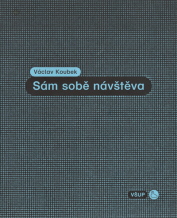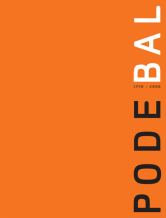| Revista Umělec 2010/1 >> Entropie | Lista de todas las ediciones | ||||||||||||
|
|||||||||||||
EntropieRevista Umělec 2010/101.01.2010 Michal Vimmer | en cs de |
|||||||||||||
|
in OPEN SPACE / What Would the Gallows be Without a Noose?
Friedrich Nietzsche, the greatest psychologist of Modern times, noticed some 125 years ago that a war over Christian heritage was raging around him; former Christians were seeking out new prophets and a new religion. From the perspective of eternity, progressive ideologies and regimes shift with the wind; nonetheless, the triumph of the design revolution has altered the face of the world for ages. Functionalism reigns, continuously spreading and conquering new realms. It follows that the irreversible success of what is considered a rationalist direction in architecture has led to the illusion that functionalism has justified itself over the decades and has become a material, true expression of reason—and an articulation of the shape of human spacial needs. Indeed, the functionalism of the ruler and the square is rational. Straight lines clearly divide the plane. Ideal right angles define boundaries of the plane completely. Bare planes enable absolute human proximity and immediate contact. The ground-plan and the volumes of real estate can be completely calculated, measured and appraised. After a century, functionalist design remains a “new,” Modern morphological phenomenon, and will linger on as a new form. If the quality of function is defined by the measure of practicality for its user - the inhabitant, man, then there is nothing like functionalism anywhere in the biosphere. The three worlds of natural life—fungi, plants, and animals from the single-cell to the largest organisms—know neither straight lines nor right-angles. Whether living creatures spend their time in one place or move, they have to adapt to the surrounding environment and to each other; they have to live in the wilderness among neighbors, competitors and predators. In the present climate with everything in movement and flux, the chain of generations of one species always puts the best it can provide to an unrepeatable test. They’ve got to; it either is, or is not. Living nature revels with shapes and colors in warm seas and tropical rain forests where there’s a cornucopia of resources and variety of competitors. But nowhere in the living world can we find a angular eye, kidney, liver, fish, wild mushrooms, moss, snakes, porcupines, snails, shells, an oyster, a frog, wasps or bird’s nests, onions, bats, honeycomb, turtles, ant hills, etc. Starting from fish roe, or an egg in a nest, the evolutionary design is always bent around, curvy, resistant and adapted to the elements. Not even the anatomy of a human, the peak of evolution, is an exception to this natural design. The essential everyday objects—pillows, quilts, plates, pots, cutlery, washbasins, the hole in an outhouse, the toilet bowl, gutter and water channels have been the same: they are curvy. However, with such things as tables, beds, chairs, and any furniture and household appliances, it gets more complicated. It would indeed be rather odd to come across an angular plate; but stranger still would be to find a round table or bed. The inhabitant of a Modern city, with all it corners and edges, has to cope with Modern edgy things and straight lines with respect and caution: go forward, step back, turn to the right, turn to the left. The inhabitant must adapt to the design—or be punished. Angular design sets completely clear rules, and if a person complies with them, the risk of injury, trauma or death, which otherwise lies in wait behind every corner, is reduced. Functionalism responds to the particular needs of machines that glide along rails on a linear axis that, with mathematical precision, mimic crystalline structures. Rationalist design departs from historical natural selection. Function is not evolutionary, but revolutionary; the winner of the last revolution is always the final chapter of progress. In the beginning of functionalism was the word. The initial conceptual refusal of history is followed by a claim to physically destroy the past. Functionalism answers the needs of a revolutionary interpretation of the world, seeking new beginnings upon which to build civilization. Since we are dealing with a revolution from above, with a non-public program lacking the support of the masses, the revolt in design could be embodied only through a link with a ruling power and huge theoretical effort. The apostle of the functionalist revolution had become the Viennese architect Adolph Loos. Loos’ 1908 manifesto “Ornament and Crime” is the cornerstone of all buildings of the future. In reaction to the ornamental orgies of the Art-Nouveaux era, the last style without any prescribed dogma, Loos had accused and sentenced ornamentation to the ash-heap of history. According to Loos, all evolution, so far, has been heading toward rejecting ornament, the erasing of «primitive» cultural embellishments. Loos’ fellow traveler, the Swiss architect Le Corbusier, in 1923 theoretically banished all decoration, colors and shapes that were more complex than simple geometry. He sought the leveling of Paris in order to open up space for engineering mechanically harmonic aesthetics—a machinery in the image of the American production line, and with the concrete sculptures representative of power. The representatives of revolutionary design—who offered their visions and projects to the service of new Utopian dictatorships—have succeeded. The first to succeed were the Italian Modernists in Fascist Italy. Later, Le Corbusier was accepted in the Soviet Union. Hitler, himself an admirer of neo-romantic architecture, rejected the claims of Bauhaus, but in emigration, the German design school has celebrated the unconditional capitulation of historicism with the creation of monuments to American liberalism. The architect, P. C. Johnson, Hitler’s admirer, has made an essential contribution to the German victory in America. No philosophy, creed or ideology, by the creator of the producer or user of goods, says anything good about the use-value of goods or system. Function has nothing in common with character, ethics, taste. Allegedly. However, when the World Trade Center was demolished in September 2001, the entire world came to see the event as a barbarian attack upon the pillars of free society, on the heart of free trade and entrepreneurial spirit, on the basis of the advanced Modern western civilization—an attack upon the very symbols of democracy. During the moaning and rage over the detritus of New York skyscrapers, it was inappropriate to inquire how democratic life was within those giant towers—and in their shade. The practical reason for constructing high-rise buildings and increasingly taller skyscrapers is land value. The tax for tallness is an persistent gloom and greenhouse atmosphere, an increased risk of damaging vertical wiring and piping network, dependency on elevators, air conditioning, and openness of the lower floors when energy, water and heat come up from below. The only way out from the tower leads downwards. The corporations that are seated at expensive addresses, on the upper floors, do not decide democratically, of course, but according to the will of the owners. The vertical function is expressed through the horizontal articulation of the office terrarium: the employees are visibly distributed behind glass, on a minimally divided area, in right-angled cubicles deprived of privacy. Why should a tall perpendicular block, with shiny sparse concrete glass and steel walls, be a symbol of freedom and democracy? The traditional symbols—archetypes —do require only minimal ideological commentary. Indeed, they are powerfully influential even to the uninitiated layman. Archetypes eternally return, do not get lost, reoccurring in new cultural forms. When the Christian God had departed, those who outlived him, in the resultant void and darkness, returned to myth. The Viennese Otto Weininger in his book, Gender and Character (Vienna, 1903) inspired his contemporaries with the power of mythical associations. He argued that the decline of society, the lacking of genius, can be attributed to the rise of the female principle as rendered visible in Jews and homosexuals. Weininger, himself a Jew and homosexual, made his work famous by suicide when he was 23 years old, in the same house where Beethoven—whom Weininger called the last genius—died. Weininger’s misogynist thesis achieved considerable applause and influence in both the Viennese and European intellectual spheres; and Adolf Loos was no exception. The woman is evidently animal-like, empty, base, superficial, dumb, randy, lustful, vain, passive, impulsive, volatile, spontaneous, and submissive, darkness itself; the male principle is her luminous counterpart. Man is light, day and spirit. Man is the sun. Woman—cold like the pale moon—is merely his reflection and is steeped in darkness. Man is creator and progress; woman is passive substance, stagnation and tradition. Man is culture, science, order and civilization; woman is chaos and barbarism. Man is pure and his expression is clear. Woman veils herself in a fog of perfumes, cosmetics and intrigues in order to cover her substantial sinful dirt. If direct, precise, clear, straight, tall, sharp, hard and angular are masculine adjectives then all disparities, flaws, curves, soft, low, and rounded forms have to be exterminated as attributes of the feminine element. Because women—like primitives, slaves, inferior races and children like ornaments, jewels, trinkets, embellishments and colours—then let them be swept away, as Loos and Le Corbusier agreed. Man is always handsome, but woman tends to be ugly. Thus the arch as a shape, pregnant with impurity, was rationally expelled from Modern architecture, without regard to its supporting advantages, just like the original, ideal Greek democracy rationally expelled from the decision-making process the de-facto indispensable, but interchangeable, women and slaves. Modernists took hold of the forsaken Christian cross and used it to case the world within bars. The chaos in the face of civilization’s polished glass will not cease by mere forbidding. There is only one nature, and it can’t tolerate asymmetry. Amorphous entropy incessantly runs against artificial order given by command. The cornered elements will not tire until the links of the tubes and fixture welding come undone; they will not smooth the edges of steps, and won’t break crossbeams of arcades, or wear-away the whitewash to expose bleeding ribs. Traffic balance will not be established until car-wrecks block the crossroads of death. The blind walls of deserted corridors are being assaulted by the wild calligraphy of graffiti, the population is getting fat, takes drugs, getting pierced and tattooed and the horizons of western cities swell with ornamental domes of mosques. Whoever places a wreath on a grave, dental prosthetics on a window sill, shortens one’s way across a public park, hangs a teddy bear in a cubicle of open space, sticks banana stickers on the fridge, gnaws—urged on by the darkness of the unconscious, the outside, the right-angled world. In the same manner, Picasso framed his cubist paintings within an oval. Adolf Loos wrote in his book, Ornament and Crime, “If Modern man gets tattooed, he’s either a criminal or a degenerate. No wonder there are prisons in which 80 percent of the inmates are tattooed. The ones who are tattooed, and not presently in jail, are latent criminals or degenerated aristocrats. If a tattooed person dies free, it is merely due to the fact that he died a few years before committing a murder.” Living freedom of choice should not be limited to the choosing of whether to get a tattoo, piercing—or to get fat.
01.01.2010
Artículos recomendados
|
|||||||||||||
|
04.02.2020 10:17
Letošní 50. ročník Art Basel přilákal celkem 93 000 návštěvníků a sběratelů z 80 zemí světa. 290 prémiových galerií představilo umělecká díla od počátku 20. století až po současnost. Hlavní sektor přehlídky, tradičně v prvním patře výstavního prostoru, představil 232 předních galerií z celého světa nabízející umění nejvyšší kvality. Veletrh ukázal vzestupný trend prodeje prostřednictvím galerií jak soukromým sbírkám, tak i institucím. Kromě hlavního veletrhu stály za návštěvu i ty přidružené: Volta, Liste a Photo Basel, k tomu doprovodné programy a výstavy v místních institucích, které kvalitou daleko přesahují hranice města tj. Kunsthalle Basel, Kunstmuseum, Tinguely muzeum nebo Fondation Beyeler.
|






































 We Are Rising National Gallery For You! Go to Kyjov by Krásná Lípa no.37.
We Are Rising National Gallery For You! Go to Kyjov by Krásná Lípa no.37.
Comentarios
Actualmente no hay comentariosAgregar nuevo comentario